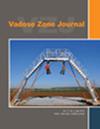稳态饱和条件下磷和氮的优先流动
IF 2.8
3区 地球科学
Q3 ENVIRONMENTAL SCIENCES
引用次数: 0
摘要
在农田中重复施用肉鸡粪便会导致地下污水中的养分富集,尤其是在存在优先流经土壤大孔的情况下。以往对土壤大孔隙进行量化的研究并未尝试建立土壤大孔隙特征与地表下养分(氮[N]和磷[P])损失之间的联系,也未涉及田间不同地形位置的土壤大孔隙。本研究调查了在美国阿拉巴马州的一块免耕牧场中,在不同地形位置(上坡、中坡和下坡)施用肉鸡粪便和优先流对地下养分运输(氮和磷)的影响。使用了 12 个完整的土壤柱(直径 150 毫米,长度 500 毫米),并将实验室实验的养分沥滤测量结果与使用 X 射线计算机断层扫描图像分析和溶质迁移模型量化的土壤大孔特征联系起来。处理方法包括表面撒播肉鸡粪便(5 兆克/公顷-1,以干基计)和无添加对照。对渗滤液进行了溶解活性磷 (DRP)、总磷 (TP) 和硝酸盐 + 亚硝酸盐-氮 (NO3- + NO2--N)分析。溴化物突破曲线证明了所有塔中的优先流。施用垃圾大大增加了沥滤液中的磷浓度,与下坡位置的沥滤液相比,上坡沥滤液中的平均 TP 和 DRP 浓度明显更高。在所有处理柱中,沥滤液中的 NO3-N 浓度都超过了美国环保局规定的 10 mg L-1 饮用水标准。在上坡处理柱中,TP 和 DRP 的流量加权平均浓度最高,分别为 2.7 和 2.5 mg L-1。不同地形位置的土壤理化性质和养分沥滤损失差异很大,这表明有必要采用不同的垃圾施用量,以减少田间易受影响位置的磷积累和随后的沥滤。本研究中发现的地形位置对养分沥滤影响的相关性应通过调查牧场中更广泛的坡度和土壤类型来进一步检验。本文章由计算机程序翻译,如有差异,请以英文原文为准。
Preferential flow of phosphorus and nitrogen under steady‐state saturated conditions
Repeated broiler litter application on agricultural lands can cause nutrient enrichment of subsurface effluent, especially with the existence of preferential flow through soil macropores. Previous studies quantifying soil macropores have not attempted to establish a connection of soil macropore characteristics with the subsurface nutrient (nitrogen [N] and phosphorus [P]) losses, across different topographical locations in the field. This study investigated the effect of broiler litter application and preferential flow on subsurface nutrient transport (N and P) at different topographical positions (upslope, midslope, and downslope) in a no‐till pasture field located in Alabama, USA. Twelve intact soil columns (150 mm id and 500 mm length) were used, and the nutrient leaching measurements from laboratory experiments were linked to soil macropore characteristics quantified using X‐ray computed tomography image analysis and solute transport modeling. Treatments included surface broadcast broiler litter (5 Mg ha−1 , on dry basis) and unamended control. Leachates were analyzed for dissolved reactive P (DRP), total P (TP), and nitrate + nitrite‐N (NO3 − + NO2 − –N). The bromide breakthrough curves provided evidence of preferential flow in all columns. Litter application significantly increased leachate P concentrations, and average TP and DRP concentrations were significantly higher in the leachate from upslope columns compared to those at downslope location. The NO3 − –N concentrations in leachate exceeded the US EPA drinking water standard of 10 mg L−1 in all the treatment columns. The highest flow‐weighted mean concentrations of TP and DRP, at 2.7 and 2.5 mg L−1 , respectively, were recorded in the upslope columns. Soil physicochemical properties and nutrient leaching losses varied substantially across topographical positions, indicating a need for variable litter application rates to reduce P build‐up and subsequent leaching in vulnerable locations within the field. The relevance of the effect of topographic position on nutrient leaching found in this study should be further tested by investigating a wider range of slopes and soil types in pastures.
求助全文
通过发布文献求助,成功后即可免费获取论文全文。
去求助
来源期刊

Vadose Zone Journal
环境科学-环境科学
CiteScore
5.60
自引率
7.10%
发文量
61
审稿时长
3.8 months
期刊介绍:
Vadose Zone Journal is a unique publication outlet for interdisciplinary research and assessment of the vadose zone, the portion of the Critical Zone that comprises the Earth’s critical living surface down to groundwater. It is a peer-reviewed, international journal publishing reviews, original research, and special sections across a wide range of disciplines. Vadose Zone Journal reports fundamental and applied research from disciplinary and multidisciplinary investigations, including assessment and policy analyses, of the mostly unsaturated zone between the soil surface and the groundwater table. The goal is to disseminate information to facilitate science-based decision-making and sustainable management of the vadose zone. Examples of topic areas suitable for VZJ are variably saturated fluid flow, heat and solute transport in granular and fractured media, flow processes in the capillary fringe at or near the water table, water table management, regional and global climate change impacts on the vadose zone, carbon sequestration, design and performance of waste disposal facilities, long-term stewardship of contaminated sites in the vadose zone, biogeochemical transformation processes, microbial processes in shallow and deep formations, bioremediation, and the fate and transport of radionuclides, inorganic and organic chemicals, colloids, viruses, and microorganisms. Articles in VZJ also address yet-to-be-resolved issues, such as how to quantify heterogeneity of subsurface processes and properties, and how to couple physical, chemical, and biological processes across a range of spatial scales from the molecular to the global.
 求助内容:
求助内容: 应助结果提醒方式:
应助结果提醒方式:


